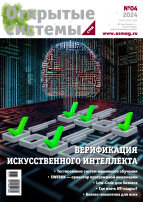COVER FEATURES
TRUSTED OPERATING SYSTEMS
KasperskyOS: Everything is Forbidden Which is not Allowed
In 2016, Kaspersky Lab announced the availability of its own operating system aimed at securing the operation of network devices by protecting them not only from external threats but also from each other.
Andrey Nikishin (Andrey.nikishin@kaspersky.com), Head of Department for Technology Projects Development, Kaspersky Lab (Moscow).
Alt OS: an Enterprise Class Platform
The Alt operating system developed in Russia enables deploying secure scalable platforms to support corporate IT infrastructure lifecycle.
Dmitry Derzhavin (dd@basealt.ru), lead engineer, Basealt SPO (Moscow).
MAKS: A Real-Time Embedded Software Platform
AstroSoft has developed a real time operating system which combines not only basic functions expected from this type of a platform but also a number of differentiating features allowing to speed up embedded software development for devices based on microcontrollers.
Alexander Kucherov (alexander.kucherov@astrosoft.ru), MAKS RTOS Project Manager, AstroSoft (St. Petersburg).
Mandatory Access Control in Operating Systems and Databases
While there is no mandatory access control in Linux, its use for various applications requiring privacy protection creates the need to secure the open-source OS working in conjunction with databases. In those settings, ensuring security requires a cross-platform solution.
Valery Popov (v.popov@postgrespro.ru), Head of IT Security and Certification Group, Postgres Professional (Moscow).
PLATFORMS
The Chinese CPU and Supercomputer Way
By the end of 2016, Western countries had to recognize that peak performance of both supercomputers and CPUs from China is greater than that of similar U.S. systems, with Chinese engineers having proved they are able to surpass the West in high-performance computing.
Mikhail Kuzminsky (kus@free.net), research fellow, N.D. Zelinsky Institute of Organic Chemistry (Moscow).
SECURITY
Privacy Risks in Intelligent User Interfaces
Intelligent user interfaces (in games, for example) provide opportunities for producing a high-quality, contextually relevant user experience. However, they also raise the specter of privacy violations. The authors review some of the ways in which user interfaces could glean a user`s private information; then the authors highlight the risks therein, and discuss ways of mitigating those risks.
Christopher J. Hazard (cjhazard@hazardoussoftware.com), founder of Hazardous Software; Munindar P. Singh (singh@ncsu.edu), computer science professor, North Carolina State University.
SOFTWARE ENGINEERING
Building Critical Applications Using Microservices
With system software bugs to be inevitably used for attacks, mission critical applications must not be dependent on the correctness of low-level code. The use of microservices and protected memory areas such as Intel Software Guard Extension minimizes trusted computing base and ensures the necessary application reliability without trade-offs.
Christof Fetzer (christof.fetzer@tu-dresden.de), professor of computer science, Technische Universitat Dresden.
INTERNET OF THINGS
The Internet of Battle Things
On the battlefields of the future, multitudes of intelligent things will be communicating, acting, and collaborating with one another and with human warfighters. This will demand major advances in science and technology.
Alexander Kott, Ananthram Swami, Bruce J. West, ({alexander.kott1.civ, ananthram.swami.civ, bruce.j.west.civ @mail.mil}), research scientists, US Army Research Laboratory.
EXPERIENCE
Open Source Software Adoption Lessons from Linux in Munich
Over 10 years, the city of Munich migrated 15,000 PCs from Windows to the open source Linux operating system. Based on this case, the authors propose recommendations for evaluating and calculating the risks of open source software adoption.
Mario Silic (mario.silic@unisg.ch), postdoctoral researcher at Institute of Information Management, University of St. Gallen, Switzerland; Andrea Back (andrea.back@unisg.ch), full professor of management and information systems, University of St. Gallen, Switzerland.
THE WORLD
Teaching programming during IT revolutions
In IT there is a permanent revolution: technologies, tools change, fundamentally new solutions appear. How in these conditions to organize the learning process, to prepare competent programmers, based on fundamental knowledge in the implementation of applied developments?
Victor Ivannikov
It All Comes Down to Memory
While offering high performance and scalability not achievable with traditional solutions, the in-memory storage and processing technology developed by GridGain Systems is capable of much more than that due to the diversity of workloads and data it is capable of handling.
Natalya Dubova (osmag@osp.ru), science editor, Open Systems Journal.DBMS (Moscow).
OS ACADEMY
Cross-Language Identification of research publication authors
Correct identification of authors of research publications is an important factor of evaluating their productivity. Regrettably, errors of identification of Russian authors of English publications are still frequent and lead to an incorrect evaluation of h-index. This paper describes an algorithm establishing a cross-language identity of the authors of research publications. The algorithm is based on a combination of extended transliteration of personal names, attribute-based identity resolution, and text analysis of publications.
Zinaida Apanovich (apanovich@iis.nsk.su), senior researcher, IIS SBRAS, Russian Federation (Novosibirsk).
LIBRARY
Computer’s 50th anniversary
The December, January and February issues of Computer magazine (IEEE Computer Society, Vol. 49, No. 12, 2016, Vol. 50, No. 1, 2 2017) are focused on group interaction of devices, the future of computing, and human augmentation technologies.
Alexander Tyrenko (shoorah@osp.ru), reviewer, Computerworld Russia (Moscow).

